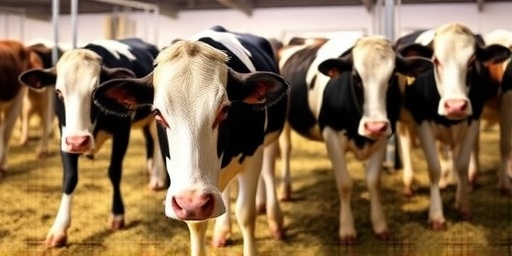In a startling development for the U.S. dairy industry, the U.S. Department of Agriculture (USDA) has confirmed the presence of highly pathogenic H5N1 avian influenza—commonly known as Bird flu—in several dairy cow herds in California. The announcement, made on Friday, prompted swift quarantine measures and mandatory testing protocols for milk to curb potential spread and safeguard public health. No human cases linked to these infected herds have been reported, but officials are urging heightened vigilance.
California, the nation’s top milk-producing state, now joins a growing list of states grappling with this mammalian spillover of the virus, which has ravaged wild birds and poultry flocks nationwide. The USDA’s Animal and Plant Health Inspection Service (APHIS) identified the cases through routine surveillance, marking the first detection of Bird flu in dairy cows in the state.
California Dairy Herds Hit by H5N1: Details of Initial Outbreak
The outbreak was first detected in Fresno County, where veterinary testing confirmed H5N1 in symptomatic dairy cows exhibiting reduced milk production, lethargy, and respiratory issues. According to USDA statements, at least four herds have been affected so far, involving hundreds of animals. Affected cows showed clinical signs consistent with previous Bird flu detections in dairy cattle across states like Texas, Michigan, and New Mexico since March 2024.
‘These are the first confirmed cases in California dairy cows, but the virus’s ability to jump from birds to mammals underscores the need for rapid response,’ said Dr. Rosemary Sifford, USDA Chief Veterinary Officer, in an official release. The H5N1 strain, part of the Goose/Guangdong lineage, has a 96% genetic match to the Eurasian variants circulating in wild birds, highlighting its wild-animal origins.
State agriculture officials reported that the infected herds were placed under immediate quarantine, restricting animal movement and requiring enhanced biosecurity measures. Milk from affected cows is being discarded, as the virus can shed into milk at high concentrations, though pasteurization effectively inactivates it.
USDA Rolls Out Quarantine and Milk Surveillance Mandates
In response, the USDA has issued federal quarantine orders for the affected premises, prohibiting the movement of cattle, equipment, or personnel without approval. This mirrors actions taken in other states, where over 80 dairy herds have tested positive since the virus began infecting U.S. cattle earlier this year.
Mandatory testing is now required for all lactating dairy cows showing symptoms, with bulk milk tank surveillance expanded nationwide. The USDA’s National Milk Testing Strategy, launched in late 2024, aims to sample one million tanks monthly by January 2025, using PCR tests to detect viral RNA. In California, the California Department of Food and Agriculture (CDFA) is coordinating with federal teams to trace contacts and monitor adjacent herds.
- Key Quarantine Protocols: No animal movement in or out of quarantined sites for 30 days post-last case.
- Milk Testing: Daily sampling from symptomatic herds; pasteurization confirmed safe by FDA.
- Biosecurity: Enhanced cleaning of milking parlors and restrictions on wild bird access.
‘Quarantine is our first line of defense to prevent further spread in this critical dairy state,’ emphasized CDFA Secretary Karen Ross. Federal funding of $1 billion has been allocated for indemnity payments to farmers culling infected animals, easing economic burdens.
No Human Cases Yet, But Milk Safety Under Scrutiny
Public health officials stress that the risk to humans remains low. The CDC reports over 50 human cases nationwide since 2024, mostly mild among farm workers exposed to infected poultry or dairy cows, with no sustained person-to-person transmission. In California, no illnesses have been tied to these dairy cases.
However, concerns linger over raw milk consumption. The FDA warns against drinking unpasteurized milk from potentially affected areas, as viable H5N1 virus has been cultured from raw samples of sick cows. Pasteurized milk, processed at 161°F for 15 seconds, renders the virus non-infectious.
‘While pasteurization protects the commercial milk supply, consumers should avoid raw milk products amid this outbreak,’ stated FDA Commissioner Robert Califf. Studies from infected herds show viral loads up to 10^9 particles per milliliter in raw milk, but zero in pasteurized samples.
California’s robust dairy testing infrastructure, processing over 40 billion pounds of milk annually, positions it well for containment. Retail surveys show no detectable virus in store-bought milk, reassuring consumers.
Dairy Industry Braces for Economic Ripple Effects
California’s dairy sector, valued at $7.5 billion yearly and supporting 1,700 farms, faces immediate challenges. Milk prices have ticked up 2-3% in spot markets due to supply fears, though national production dipped only 1% since spring outbreaks.
Farmers like John Muller of Fresno-based Valley Milk Ranch expressed frustration: ‘We’ve ramped up testing and biosecurity, but the quarantine hits hard—lost production means lost revenue.’ Industry groups estimate $500 million in potential losses if cases spread unchecked, prompting calls for vaccine research acceleration.
The USDA is exploring cattle vaccines, with trials underway at labs like Kansas State University. Meanwhile, export markets remain stable, as trading partners like Canada and Mexico accept U.S. assurances on surveillance.
Broader context: Bird flu has culled 100 million poultry since 2022, costing $4 billion, but dairy impacts are novel. Genetic sequencing reveals cow-adapted mutations, raising questions about mammalian evolution of the virus.
Surveillance Expansion and Path Forward for Containment
Looking ahead, the USDA plans nationwide genomic surveillance, partnering with the CDC and state labs to track H5N1 variants. California’s early detection, via voluntary reporting, exemplifies proactive measures.
Experts predict seasonal peaks with wild bird migrations, urging year-round vigilance. The Interagency Coordination Group on HPAI is convening next week to refine strategies, including wildlife management and farmer education.
‘This is a wake-up call for integrated One Health approaches—linking animal, human, and environmental health,’ noted Dr. Angela Rasmussen, virologist at University of Saskatchewan. Long-term, diversified biosecurity and rapid diagnostics could mitigate future spillovers.
As quarantines hold and testing ramps up, the dairy industry eyes recovery. Consumers can rest assured: the pasteurized milk supply chain remains robust, with no evidence of widespread contamination. Officials vow to keep the public informed, prioritizing transparency in this evolving bird flu saga.









